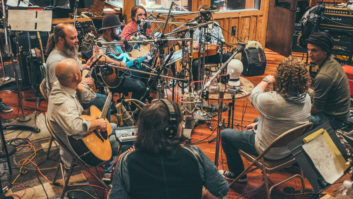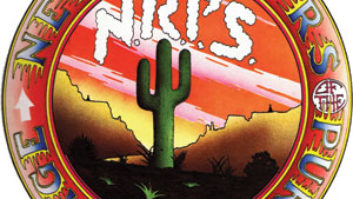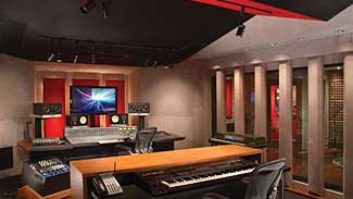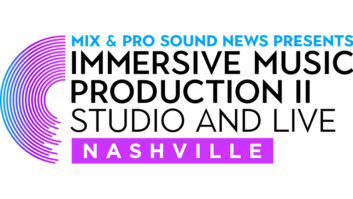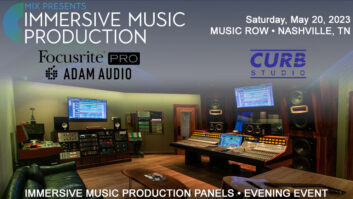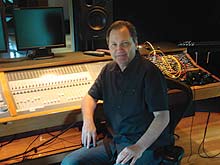
Steve Wariner uses two Sony DMX-R100s, joined to form a “Baby Oxford.”
Photo: Peter Cooper
With the help of a cappuccino machine, some ribbon mics and a Chris Huston-designed home studio, Grand Ole Opry member Steve Wariner set about recording an album to honor the memory of his greatest musical influence, Chet Atkins.
“It started with me just sitting around the studio, playing a piece that Chet had recorded called ‘Blue Angel,’” says Wariner, who produces his own albums on his independent SelecTone Records. “I wound up recording it, and then I put some upright-bass down, and started liking the way it was turning out. I pulled out Chet’s record from the 1960s, and it had castanets on it, so I started looking around the studio for something that could sound like that. I set up a Shure SM57 mic and was tapping anything I could find. Finally, I got the little cappuccino thing out, with the metal top on it, and tapped on it with part of a woodblock — instant castanet. I kept working, and the record really started there.”
In some way, the record — called Steve Wariner, c.g.p.: My Tribute to Chet Atkins — began decades ago, when Wariner first met the man whose guitar licks he’d been emulating since childhood. In addition to being among the world’s finest and most influential guitarists, Atkins was producing records and running Nashville’s branch of RCA Records in the 1970s, and Wariner was in the uncomfortable position of having to hector a hero for a record deal.
“Oh, I was scared to death around him,” Wariner says. “Soon after I met him, he called me, and said, ‘I’m going to be at [RCA] Studio B on Wednesday if you want to come down.’ I thought it was just going to be Chet, and when I got there I saw Jerry Reed, who was working on an album with Chet. Chet said, ‘Steve, do that song of yours, “I’m Already Taken,” for Jerry here.’ I played the song, and Jerry goes, ‘Damn, Chet. Sign this boy. What do you want, blood?’ Chet just chewed on his cigar and didn’t respond.”
The men ultimately became close, and Wariner got his record deal. Wariner paid close attention to Atkins’ guitar work and to his production style (“He didn’t manage everything to death — just brought in great players, found great songs and let everybody do what they do,” Wariner says). In putting the tribute album together, Wariner sought to replicate certain elements of Atkins’ approach but not to make an album that sounded like a time capsule. He wrote songs for the project, including “Leavin’ Luttrell,” “Leona” and “Chet’s Guitar,” playing the latter tune on, yes, one of Atkins’ guitars.
“I didn’t try to match original recordings of Chet’s,” Wariner says. “I wanted to have the warmth of his old records, but also to have the sound be crisp and bright and somewhat modern. We recorded on my board, which is two Sony DMX-R100s — they call them the ‘Baby Oxford’ — put together. They may be a little out-of-date now, but I know them and I really like the sound. [Engineer] Randy Gardner and I cut to RADAR, and then we mixed to a 1973 Ampex ATR half-inch machine. We’ve done the acid test on digital as opposed to mixing to the Ampex, and this way there’s so much more warmth, no question to me.
“One thing I did this time was to use vintage RCA ribbon mics, which I know for a fact is what Chet used on his early stuff,” he continues. “And we didn’t do a lot of outboard things, except with echo. We used an Echoplex tape loop and a new analog delay pedal from MXR called the Carbon Copy. And also, I used a Lexicon LXP-15 II, because when I traveled with Chet he used that one.”
Wariner’s studio is above the garage at his Franklin, Tenn., home. He uses it mostly for his own projects, but he has also recorded others there (including some of Jerry Reed’s final sessions). Chris Huston — the Liverpool-reared producer and engineer who worked with James Brown, The Who, Led Zeppelin, Van Morrison and others — designed the studio with the idea of making it a comfortable space for writing and casual jamming, as well as for more formal recording. There’s an elevator so heavy gear need not be hustled upstairs, and there’s enough studio floor space to handle a full band and a string section.
“Every nook and cranny of this place is wired for recording,” Wariner says. “The garage is wired in case I want to throw on some B3. And we made the control room extra big. I don’t really need this much depth for regular listening situations, but I wanted a deep wood area in the control room because I wind up recording in here just as much as in the other room. I write in here a lot, and as I’m writing I set up mics and carve out tracks.”
While the new album features some of the tricks Wariner learned from Atkins, the acolyte wouldn’t have been comfortable attempting some of Atkins’ tricks.
“There are some things he did that I’d never have the nerve to do,” Wariner says. “On one of my first sessions with him, something was wrong with the 2-inch master, and Chet said, ‘I’ll fix it.’ He reached over and pulled the tape off the machine, laid it on a block and took a razor blade to it. I stood there with my jaw open.”
To reach Peter Cooper, e-mail
[email protected].
